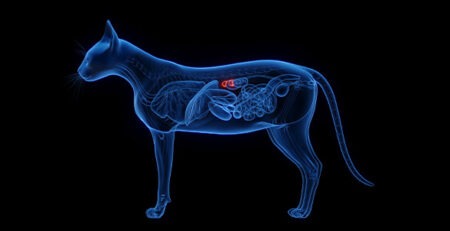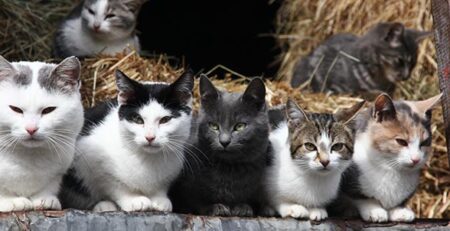Cat pheromones and marking: when the kitty rubs itself on you or on objects, it releases these substances that communicate a message such as “You are mine and this territory, too. So, everyone stay away.”
Feline pheromones are odorous substances secreted by certain glands located in different parts of the cat’s body: on the cat’s chin, cheeks, lips and paws but are also found in its urine and feces.
These particular olfactory scent signals are released in water, in the air, on the ground, on objects, and on us humans: they contain messages and communications that all cats use to interact with each other and the world around them.
But why does the cat release pheromones and what are they used for?
The pheromones emitted by the cat vary depending on the situation and circumstances.
Territoriality and urinary marking
Those emitted from the back of cats’ bodies are pheromones usually found in urine and are used to convey messages of rivalry to other individuals of the same sex, as in the case of unneutered male cats, or to indicate sexual availability, as in the case of females.
Cats sniffing urine markings learn all useful information about other cats in the territory: gender, sexual availability, hierarchy.
The information obtained conditions the cat’s behavior: for example, if it is a “rival” male, it understands when territory is already occupied and may choose to change areas to avoid conflict with the dominant male even if it perceives the presence of female cats in heat and available.
Calm, well-being and fulfillment
Nursing cats release pheromones produced by mammary area glands located around the nipples.
Also called calming pheromones, they serve to strengthen the bond between the mother cat and the kittens.
They also help kittens feel protected and safe, get along with each other, stimulate social contact and acceptance, and limit conflict and escape reactions.
Familiarity and safety
When the cat or rubs its head and snout on people and objects in the house, it deposits its facial pheromones.
But also when kneading, through the interdigital pheromones released by the fingertips of the paws and even the nails.
In doing so, it brands and qualifies people and things as safe or familiar.
This indicates that the cat feels comfortable, considers places and things pertaining to them familiar and not at all threatening.
In short, he is communicating to you that you belong to him, that he is happy and relaxed and feels fulfilled and safe in his environment.
How pheromones are perceived by the cat: the flehmen and the vomero-nasal organ
Flehmen is a biological mechanism that the cat enacts when it senses pheromones: it basically freezes for a few moments, wrinkles its nose, retracts its upper lip, holds its mouth slightly ajar and moves its tongue.
The opening of the mouth and the movement of the tongue promote the passage of pheromones directly into thevomeronasal organ (also called Jacobson’s organ), which is a specialized sensory organ located on the cat’s palate.

The vomero-nasal organ transmits information through the nervous system directly to the brain to decode the messages contained in the pheromones.
vibrissae
, the vomero-nasal organ is also an endowment that enables the cat to do truly amazing, almost magical things.
In the cat, therefore, vocal communication plays a very marginal role.
Rather, its main communication channel is the olfactory one that is totally precluded to us humans.
So, since the basis of the cat’s behaviors are the stimuli it receives from the environment, take care not to upset it inappropriately, annoy it or create stress and anxiety for it with strong odors such as those of some household and room cleaners or with particularly penetrating and persistent scents.
We also remind you that in case of need and urgency Clinica La Veterinaria is always open h24 every day including holidays and with First Aid service from 8 pm to 8 am.











